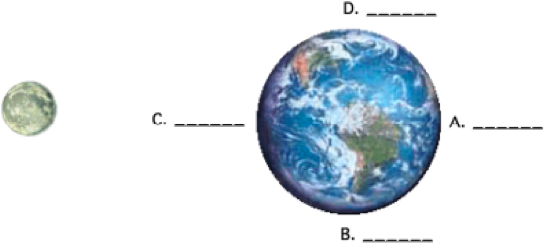| A | B |
|---|
| How long does it take for the moon to revolve around the Earth? | 27.3 days |
| What causes phases, eclipses, and tides? | They are caused by the changing relative positions of the moon, Earth, and sun. |
| What are phases? | different shapes of the moon you see from Earth |
| What does the phase of the moon you see depend on? | how much of the sunlit side of the moon faces Earth. |
| Name the phases of the moon from New Moon to New Moon. | New Moon, Waxing Crescent, First Quarter, Waxing Gibbous, Full Moon, Waning Gibbous, Last/Third Quarter, Waning Crescent |
| What is an eclipse? | When an object in space comes between the sun and a third object, ti casts a shadow on that object |
| When do solar eclipses occur? | When the moon passes directly between Earth and the sun, blocking sunlight from Earth; during the day; and during a New Moon |
| When do lunar eclipses occur? | at a full moon when Earth is directly between the moon and the sun; and during the night. |
| What is an umbra? | cone shaped, it is the very darkest part of the shadow of an eclipse |
| What is a penumbra? | the larger, outer part of the shadow caused by eclipses |
| Describe a total lunar eclipse. | During a full moon, the Earth blocks sunlight from reaching the moon. When the moon is in the Earth's umbra, you see a total lunar eclipse. |
| Describe a total solar eclipse. | During a New Moon, the moon passes directly between Earth and the sun, blocking sunlight from Earth. The moon's shadow then hits Earth. The part of the Earth that is in the umbra will experience a total eclipse. |
| Why does a partial solar eclipse occur? | A partial solar eclipse occurs because that part of the Earth is in the penumbra of the eclipse. |
| Why does a partial lunar eclipse occur? | A partial lunar eclipse results when the Earth, the moon, and the sun are not quite in line, and only a partial eclipse occurs. That part of the Earth is in the penumbra of the Earth's shadow. |
| What are tides? | the rise and fall of the ocean water that occurs every 12.5 hours or so. The water rises for about 6 hours, then falls for about 6 hours, in a regular cycle. |
| What causes tides? | Tides are caused mainly by differences in how much the moon's gravity pulls on different parts of Earth. |
| What are Spring Tides? | A tide that occurs during New Moon and Full Moon. The gravity of the moon and the sun combine to produce a tide with the greatest difference between consecutive low and high tides: in other words, there will be higher than normal high tides, and lower than normal low tides |
| What are Neap Tides? | The sun's pull is at right angles to the moon's pull This occurs during First and Last/Third Quarter Moon, there is the least differenct between consecutive low and high tides. |
| What phases of the moon do Spring Tides occur? | New Moon and Full Moon |
| What phases of the moon do Neap Tides occur? | First Quarter Moon and Last/Third Quarter Moon |
Label the high and low tides.,  | A & C are High Tides and B & D are Low Tides.,  |